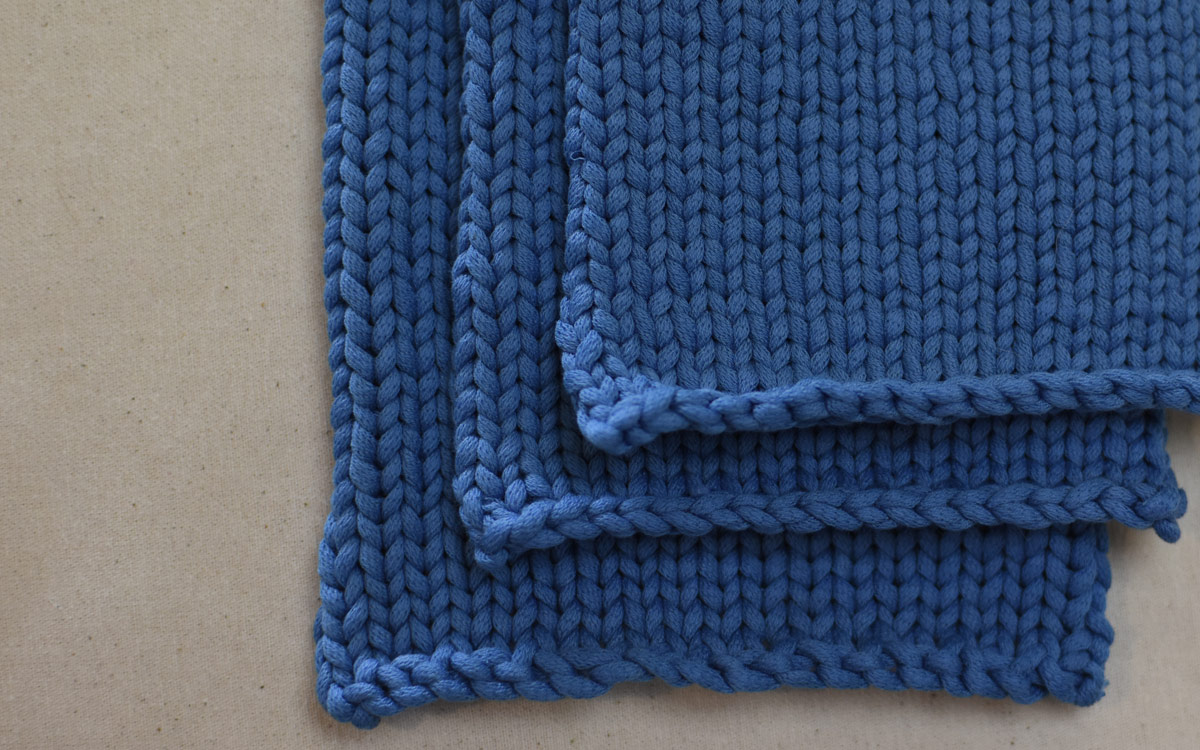1. Choose yarn that’s easy to work with.
There are so many different varieties of yarn to choose from: thick vs. fine, fluffy vs. smooth, natural fibers vs. man-made fibers. When you’re first starting out, it’s easy to get caught up in all the different beautiful options, but it’s probably best to pick a yarn that is easy to hold and lets you easily see and count your stitches.
A thick, wavy yarn looks great when used for a simple beginner project like a scarf, but it’s often very stretchy and uneven. This not only makes it harder to see your stitches, but it increases the difficulty of keeping your tension loose and even. If you make a mistake, the yarn can also stick to itself (or you might have split the yarn while making stitches), and can be next to impossible to frog (undo/rip out).
It’s best to start off with a really simple basic yarn, like worsted weight* acrylic yarn. The stitch definition is easy to see, it feels nice in your hands, it’s not stretchy or fluffy, and it’s easy to undo should you make a mistake.
*Worsted weight yarn is typically a yarn with a weight number of 4.
2. Start with an easy pattern.
There’s a lot to figure out when you first begin learning how to crochet or knit. Why not make it easier on yourself and start off with something easy, like a simple scarf or baby blanket? It might seem repetitive to do the same basic stitch over and over again, but you’re building the base skills you need to move on to more advanced and complicated projects. Making a blanket that is all a single simple stitch (like single crochet or just the knit stitch) lets you concentrate on perfecting the basics:
- how to hold the yarn
- how to hold your hook or needles
- tension
- keeping track of the number of stitches per row
- making stitches consistent and even
- reading the pattern
As your skills grow and you become more comfortable, you can choose more intermediate or advanced patterns. You need to learn to walk before you can run!
3. Work in a comfortable, distraction free place.
It’s hard to concentrate when you’re constantly interrupted, or something about your setting is annoying you. Even something as simple as having a conversation with someone is enough to throw your mind off the task at hand. Find a nice place you can relax in. For some people, this can be a quiet corner of their home. Others find sitting in a place with background noise, like a coffee shop, helps them focus.
Most people eventually become comfortable enough to chat while they work on their projects. Some can even watch TV!
4. Have a good visual stitch reference on hand.
How do I do a double crochet stitch? Where does my yarn go when I’m purling? When you’re first starting out, it’s easy to forget how to make a certain stitch, or need intricate detailed instructions. (Even a seasoned veteran sometimes forgets how to do a particular cast on method!) It’s always nice to have a guide nearby that you can turn to when you need help or just a little bit more explanation, whether it’s a book, a printout, or something you’ve bookmarked on your phone.
Our Yarn Crafter app has an ever-growing stitch library that explains, step-by-step, how to create a wide variety of stitches. In online mode, YouTube videos are available to watch while offline mode offers slideshows of photographs detailing each step. And because it’s on your phone, these references will always be at your fingertips!
5. Be patient with yourself.
It can take awhile before things you make look the way you want them to, but don’t be discouraged. Keep trying, and be excited about the little victories, like finally finding a comfortable way to hold your yarn and hook/needles or your stitches being visibly straighter and more consistent with each row you do. Practice makes perfect.
If you’re getting angry and frustrated, it’s okay to put your project down and walk away for a bit. Once you’ve cleared your head and can come back to it, you might even find it’s easier to pick up where you left off.


